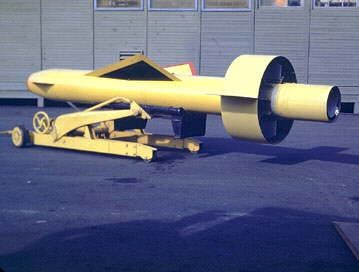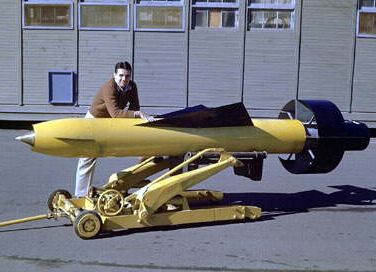P/A Series
(P/A-I through P/A-XVI)
Immediately after World War 2, the U.S. Navy's Bureau if Aeronautics (BuAer) defined a series of tentative requirements for guided missiles, which might be needed by 1950. Sixteen short-duration study contracts were awarded to the industry, labeled P/A-I through P/A-XVI. "P/A" stood for "Pilotless Aircraft", the term which was used by BuAer for guided missiles at that time. Most of the P/A studies did not result in actual hardware, because the reduced budgets of the post-WW2 era meant that many missile programs were soon cancelled. However, some of he P/A studies paved the way for actual missile prototypes of the 1950s.
Note: Project numbers P/A-II and P/A-X are missing from the list. I have no information whatsoever about these studies.
P/A-I
P/A-I was a ship-to-ship missile studied by Willys-Overland.
P/A-III
P/A-III was an anti-kamikaze surface-to-air missile studied by the NAMU (Naval Air Material Unit).
P/A-IV
P/A-IV was an anti-snooper medium/long-range surface-to-air missile studied by the NAMU, Fairchild and Consolidated-Vultee. This program was eventually combined with PA-XII, and led to the SAM-N-2/4 Lark missile.
P/A-V
P/A-V was a supersonic long-range surface-to-surface missile studied by Douglas and Goodyear. Goodyear's approach was a two-stage missile, where the 2nd stage was also separately studied as an air-to-surface weapon under the P/A-IX label.
P/A-VI
The P/A-VI (also written sometimes as P/A-6 or PA-6) study called for a short-range (45 km (25 nm)) surface-to-surface missile for landing support operations. The contract was awarded to Vought in June 1946, and the company designed a supersonic ramjet-powered vehicle. For initial tests of the design, air-dropped sub-scale testbeds were built. Because no suitable ramjet was available, the P/A-VI vehicles were only powered by an off-the-shelf rocket booster from Aerojet. The tubular missile had small horizontal foreplanes, two wings of very pronounced dihedral and a circular tail shroud. The vehicle was equipped with a telemetry system, but the only onboard instrumentation measured air-flow data in the duct to help the design of the forthcoming ramjet engine.
 |
 | |
| Photos: Vought | ||
| P/A-VI | ||
Drop tests from an F4U Corsair aircraft began in March 1947. The rocket booster could accelerate the P/A VI to about mach 1.25 within 2 seconds. However, after only two launches, the Vought P/A-VI program was terminated and the design transferred to Grumman's PA-VII program. After four additional drops, the P/A-VI flight test program was finally cancelled.
P/A-VII
P/A-VII was a medium-range (550 km (300 nm)) surface-to-surface missile studied by Grumman. It eventually evolved into the SSM-N-6 Rigel program.
P/A-VIII
P/A-VIII was a short-range air-to-underwater missile (probably some sort of torpedo carrier) studied by Martin. It was apparently cancelled very early.
P/A-IX
P/A-IX was a supersonic air-to-surface missile studied by Goodyear. It was essentially identical to the terminal stage of their P/A-V surface-to-surface missile study.
P/A-XI
P/A-XI was a short-range air-to-air missile for use by patrol aircraft. It was studied by the NAMU and McDonnell. The "short-range" definition was apparently not firm, because in other contexts the Navy defined the P/A-XI as a missile with 65 km (35 nm) range.
P/A-XII
P/A-XII was an anti-ferret short/medium-range surface-to-air missile studied by Fairchild and Consolidated-Vultee. This program was eventually combined with PA-IV, and led to the SAM-N-2/4 Lark missile.
P/A-XIII
P/A-XIII was a surface-to-surface missile of unknown specification. It was briefly studied by Martin.
P/A-XIV
P/A-XIV was a Vought study for a short-range air-to-ship missile, which was apparently cancelled very early.
P/A-XV
P/A-XV was a McDonnell study for an air-to-air missile for use by carrier aircraft. It was sometimes defined as "short range" and in other contexts with a range of 31 km (17 nm).
P/A-XVI
An ongoing study by Douglas to fit a standard 12.7 cm (5-inch) rocket with a radar seeker to create a short-range air-to-air missile became the P/A-XVI program. It eventually evolved into the AAM-N-2 Sparrow missile.
Main Sources
[1] Norman Friedman: "US Naval Weapons", Conway Maritime Press, 1983
[2] Vought Heritage Website
[3] Goodyear Aircraft Corp.: "P/A-V and IX Progress Report", November 1946
Back to Directory of U.S. Military Rockets and Missiles, Appendix 1
Last Updated: 30 April 2024